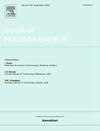二氧化碳气泡动力学和闪蒸室壁面传热:成核偏离和冷泡效应
IF 2.3
3区 工程技术
Q1 NUCLEAR SCIENCE & TECHNOLOGY
引用次数: 0
摘要
本文采用晶格玻尔兹曼方法研究了二氧化碳在过热壁面附近的减压闪蒸过程中的气泡动力学和相变传热。结果表明:气泡推进速率随过热度和接触角的增大而线性降低;同样,随着过热度的增加,分离直径呈线性减小。分离直径与接触角之间的关系受壁面润湿性的强烈影响,亲水性表面与分离直径呈负线性相关,疏水性表面与分离直径呈正线性相关。引入了基于Ca数的修正项来增强气泡上升速度的预测。传热分析表明,墙体润湿性显著影响热流密度,疏水表面将传热提高三倍。从力学上讲,低压条件下引起的冷核对于改善闪蒸传热至关重要,特别是在疏水表面上。本文章由计算机程序翻译,如有差异,请以英文原文为准。
Carbon dioxide bubble dynamics and wall heat transfer in flash chambers: Nucleation departure and cold bubble effects
This study uses the lattice Boltzmann method to explore bubble dynamics and phase-change heat transfer of carbon dioxide during reduced pressure flash evaporation near overheated wall surfaces. The findings show that the bubble advancing rate decreases linearly with increasing superheat and contact angle. Similarly, the detachment diameter decreases linearly as superheat increases. The relationship between detachment diameter and contact angle is strongly influenced by wall wettability: hydrophilic surfaces exhibit a negative linear correlation, while hydrophobic surfaces show a positive linear correlation. A correction term based on the Ca number is introduced to enhance bubble rising velocity predictions. Heat transfer analysis reveals that wall wettability significantly impacts heat flux, with hydrophobic surfaces boosting heat transfer by up to three times. Mechanistically, cold nuclei induced by low-pressure conditions are crucial for improved flash evaporation heat transfer, particularly on hydrophobic surfaces.
求助全文
通过发布文献求助,成功后即可免费获取论文全文。
去求助
来源期刊

Annals of Nuclear Energy
工程技术-核科学技术
CiteScore
4.30
自引率
21.10%
发文量
632
审稿时长
7.3 months
期刊介绍:
Annals of Nuclear Energy provides an international medium for the communication of original research, ideas and developments in all areas of the field of nuclear energy science and technology. Its scope embraces nuclear fuel reserves, fuel cycles and cost, materials, processing, system and component technology (fission only), design and optimization, direct conversion of nuclear energy sources, environmental control, reactor physics, heat transfer and fluid dynamics, structural analysis, fuel management, future developments, nuclear fuel and safety, nuclear aerosol, neutron physics, computer technology (both software and hardware), risk assessment, radioactive waste disposal and reactor thermal hydraulics. Papers submitted to Annals need to demonstrate a clear link to nuclear power generation/nuclear engineering. Papers which deal with pure nuclear physics, pure health physics, imaging, or attenuation and shielding properties of concretes and various geological materials are not within the scope of the journal. Also, papers that deal with policy or economics are not within the scope of the journal.
 求助内容:
求助内容: 应助结果提醒方式:
应助结果提醒方式:


